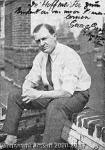George Grosz
George Grosz
Stil: Verism; Dadaism; Futurism; Cubism; Expressionism; Naive Art / Primitivism; Surrealism;
Plass: Berlin
Født: 1893
Død: 1959
Biografi:
Early Life and Influences
George Grosz, a prominent figure in the Berlin Dada and New Objectivity group during the Weimar Republic, was born on July 26, 1893, in Berlin, Germany. As Georg Ehrenfried Gross, he grew up in a devoutly Lutheran family, with his father being a pub owner. Grosz's early life was marked by his mother becoming the keeper of the local Hussars Officers' mess after his father's death in 1901.
Artistic Development
Grosz began his artistic journey under the tutelage of a local painter named Grot, further developing his skills through meticulous copies of Eduard von Grützner's drinking scenes and imaginary battle scenes. He then studied at the Dresden Academy of Fine Arts (1909-1911) and later at the Berlin College of Arts and Crafts.
Notable Works and Style
- The Pit, a painting showcasing Grosz's Dadaism style, is a notable example of his work. This piece, along with others like The Agitator and The Pillars of Society, demonstrate his satirical critique of the German bourgeois community.
- These works are characterized by their caricatural nature, often featuring morbid and gruesome imagery that symbolized fascist forces in Germany.
Museum Collections and Exhibitions
Grosz's work can be found in various museums, including the Kunstsammlungen Und Museen Augsburg and the Kunsthalle Bielefeld, both of which are renowned for their extensive collections of German art.
Later Life and Legacy
Grosz emigrated to the United States in 1933, becoming a naturalized citizen in 1938. He taught at the Art Students League of New York and continued to exhibit his work until his return to Berlin, where he passed away on July 6, 1959. Key Points: * Grosz was a prominent member of the Berlin Dada and New Objectivity group. * His work is characterized by satirical critiques of the German bourgeois community. * He emigrated to the United States in 1933 and became a naturalized citizen in 1938. * Grosz's legacy continues to be celebrated through his works, which can be found in various museums across Germany.
- For more information on George Grosz, visit https://Wikioo.org/@/George-Grosz.
- Explore the Kunstsammlungen Und Museen Augsburg collection at https://Wikioo.org/@@/A@D3B449.
- Discover the Kunsthalle Bielefeld and its extensive collection of German art at https://Wikioo.org/@@/A@D3BW2R.
References:
List of German Americans(Wikipedia)
Wikipedia link: Click Here














